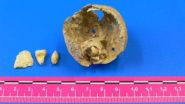(Press-News.org) WASHINGTON - African-American and Hispanic students may be less likely than non-Hispanic white students to hold a job during the school year, but when they do, they tend to work somewhat longer hours and seem less likely to see their grades suffer than non-Hispanic white students with jobs, according to new research published by the American Psychological Association.
A study involving nearly 600,000 students from around the country also found that among high school students who work long hours at a part-time job, black and Hispanic students from lower income households may be less inclined to smoke and drink than affluent non-Hispanic white or Asian-American students who work long hours. The study was published online in the APA journal Developmental Psychology.
"We know from previous research that for most students, working more than 15 hours a week is associated with various problems, including lower grades and substance use," said the study's lead author, Jerald Bachman, PhD, of the University of Michigan. "However, what we're finding with this new research is that this pattern does not seem to appear among some minority students, particularly those who come from a less advantaged background."
Overall, white students were more likely than minority students to report working during the school year, according to the study. Among 10th graders, 43 percent of non-Hispanic white students worked compared with 29 percent of African-Americans, 31 percent of Hispanics and 26 percent of Asian-Americans. Among 12th graders, 72 percent of white students worked compared with 57 percent of African-Americans, 59 percent of Hispanics and 53 percent Asian-Americans. However, although white students were more likely than other students to work, African-American and Hispanic students who held jobs were more likely to report working more than 25 hours per week. Specifically, among those 12th graders who were employed, 18 percent of Asian-Americans, 22 percent of whites, 31 percent of African-Americans and 32 percent of Hispanics reported working more than 25 hours a week.
Grade point averages among white and Asian-American students dropped dramatically the more hours they worked, while the GPAs of Hispanics and African-Americans showed less connection with hours worked, the researchers found.
"Arguably, affluent kids have the least need to work during their student days," said Bachman. "When they do work, they seem to suffer more in terms of grades and substance use. At least this is true for white and Asian-American students, whereas spending long hours on the job appears to be less harmful for African-American and Hispanic students."
The reasons for this divergent impact remain unclear, but one reason may be that African-American and Hispanic teens, especially those who live in poor urban neighborhoods, have a harder time finding work, Bachman suggested. "When they are able to land jobs, those jobs may require them to work longer hours," he said.
These findings, like previous studies of this nature, do not prove there is a direct relation between working and poor grades or behavior, Bachman noted. "Many kids who choose to work long hours already show evidence of some problems beforehand and may have a more 'rebellious' nature. But in our view, the evidence certainly does not rule out the possibility that the long hours of work add to the problems," he said.
For example, previous research has shown that teens who live in poor urban neighborhoods have fewer opportunities to find jobs than do youth in more affluent areas. Young African-Americans and Hispanics who do get jobs may be naturally harder workers and may be saving for college or to support their families and may be striving to do well in school, according to the article.
Bachman suggested that students should avoid spending a lot of time at work whenever possible. "The large bulk of research in this area suggests that students should avoid long hours of work in part-time jobs during the school year and, ideally, they should work 15 hours a week or less," he said. "Second, those who do work should try to build a 'credential' as a bright, courteous and motivated worker. As soon as they begin new jobs, students should tell employers and supervisors that they hope to earn a good letter of recommendation. If they say that right at the outset, it will help everyone view the job as an important opportunity for growth and education."
The study's nationally representative sample consisted of 314,959 10th graders and 276,026 12th graders as part of the Monitoring the Future project. These analyses were based on private and public school students who responded to surveys annually from 1991 through 2010. Students reported their average hours of work during the school year, their GPA and their levels of substance use, including cigarette smoking, pot smoking and alcohol consumption. Demographic information included gender, race/ethnicity, parental education and income, mother's employment status and how often the student had been absent from school in the last month.
###
Article: "Adolescent Work Intensity, School Performance, and Substance Use: Links Vary by Race/Ethnicity and Socioeconomic Status," Jerald G. Bachman, PhD, University of Michigan; Jeremy Staff, PhD, Pennsylvania State University; Patrick M. O'Malley, PhD, and Peter Freedman-Doan, PhD, University of Michigan; Developmental Psychology, online Jan. 14, 2013.
Full text of the article is available from the APA Public Affairs Office and at
http://www.apa.org/pubs/journals/releases/dev-ofp-bachman.pdf
Contact: Jerald Bachman at mtfinfo@isr.umich.edu or 734-763-5043
The American Psychological Association, in Washington, D.C., is the largest scientific and professional organization representing psychology in the United States and is the world's largest association of psychologists. APA's membership includes more than 137,000 researchers, educators, clinicians, consultants and students. Through its divisions in 54 subfields of psychology and affiliations with 60 state, territorial and Canadian provincial associations, APA works to advance the creation, communication and application of psychological knowledge to benefit society and improve people's lives.
www.apa.org
If you do not want to receive APA news releases, please let us know at public.affairs@apa.org or 202-336-5700.
END
ANN ARBOR, Mich. — University of Michigan research sheds new light on why certain people are more likely to suffer from rheumatoid arthritis – paving the way to explore new treatments for both arthritis and other autoimmune diseases.
The new UMHS research in mice identifies how a specific group of genes works behind the scenes to activate the bone-destroying cells that cause severe rheumatoid arthritis, a debilitating health issue for millions of Americans.
"We believe this could be a significant breakthrough in our understanding of why certain genes are associated ...
DURHAM, N.H. – There's a well-known saying in New England that if you don't like the weather here, wait a minute. When it comes to independent voters, those weather changes can just as quickly shift beliefs about climate change.
New research from the University of New Hampshire finds that the climate change beliefs of independent voters are dramatically swayed by short-term weather conditions. The research was conducted by Lawrence Hamilton, professor of sociology and senior fellow at the Carsey Institute, and Mary Stampone, assistant professor of geography and the New ...
A team of researchers led by the UAB has found the first ancient remains of a calcified ovarian teratoma, in the pelvis of the skeleton of a woman from the Roman era. The find confirms the presence in antiquity of this type of tumour - formed by the remains of tissues or organs, which are difficult to locate during the examination of ancient remains. Inside the small round mass, four teeth and a small piece of bone were found.
Teratomas are usually benign and contain remains of organic material, such as hair, teeth, bones and other tissues. There are no references in the ...
Though controversial, medical cannabis has been gaining ground as a valid therapy, offering relief to suffers of diseases such as cancer, Post-Traumatic Stress Disorder, ALS and more. The substance is known to soothe severe pain, increase the appetite, and ease insomnia where other common medications fail.
In 2009, Zach Klein, a graduate of Tel Aviv University's Department of Film and Television Studies, directed the documentary Prescribed Grass. Through the process, he developed an interest in the scientific research behind medical marijuana, and now, as a specialist ...
Michael Baum, Professor emeritus of surgery at University College London says that, while deaths from breast cancer may be avoided, any benefit will be more than outweighed by deaths due to the long term adverse effects of treatment.
He estimates that, for every 10, 000 women invited for screening, three to four breast cancer deaths are avoided at the cost of 2.72 to 9.25 deaths from the long term toxicity of radiotherapy.
These figures contrast with an independent report on breast cancer screening, led by Sir Michael Marmot and published in November last year. Marmot ...
The mosquitoes that spread dengue fever tap into the domestic networks of humans, along with their bloodstreams, finds a study recently published in the Proceedings of the National Academy of Sciences (PNAS).
The data from Iquitos, Peru, shows that the trail of the most rapid transmission of human infections does not lead through large, public gathering places, as might be expected, but from house-to-house, as people visit nearby friends and relatives.
"It's common in a dengue fever outbreak to first treat public places like schools for mosquitoes, but our results show ...
This press release is available in Spanish.
Biopesticides containing beneficial fungi are often grown on grains or other solids, but U.S. Department of Agriculture (USDA) scientists have shown a liquid diet can work better.
The approach, dubbed "liquid culture fermentation," offers several benefits, including lower material costs and increased yields of certain forms of insect-killing fungi, including Isaria or Metarhizium, which can serve as biobased alternatives to synthetic pesticides.
For decades, biopesticide makers have grown such fungi on moistened grains ...
In 1901 the star GK Persei gave off a powerful explosion that has not stopped growing and astonishing ever since. Now a team of Spanish and Estonian astronomers has reconstructed the journey of the emitted gas in 3D which, contrary to predictions, has hardly slowed down its speed of up to 1,000 km/s after all this time.
Thanks to the images captured from the Isaac Newton Telescope and the Nordic Optical Telescope in La Palma (Canary Islands, Spain), a European team of astronomers has constructed a three dimensional map of the remnant of a nova, or in other words, what ...
RUB researchers find altered connectivity in the brain network for body perception.
The weaker the connection, the greater the misjudgement of body shape
When people see pictures of bodies, a whole range of brain regions are active. This network is altered in women with anorexia nervosa. In a functional magnetic resonance imaging study, two regions that are important for the processing of body images were functionally more weakly connected in anorexic women than in healthy women. The stronger this "connection error" was, the more overweight the respondents considered ...
What to fear most if faced by a cancer diagnosis is the spread of the cancer to other parts of the body. This process called metastasis accounts for over 90% of cancer patient deaths and therefore is a strong focus for cancer researchers. Researchers at BRIC, University of Copenhagen have shown that the enzyme Lysyl Oxidase (LOX) can create a "scarred" microenvironment that enhances cancer spreading. By blocking activity of the LOX enzyme, the researchers succeeded in significantly decreasing metastasis in a model of breast cancer.
'When we inhibit the activity of LOX ...


